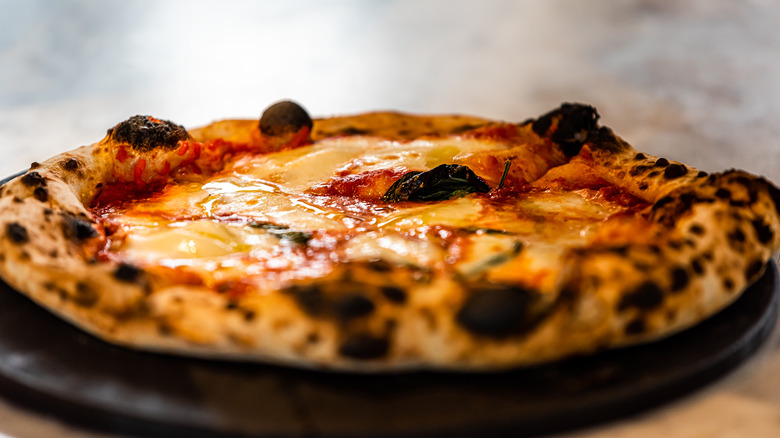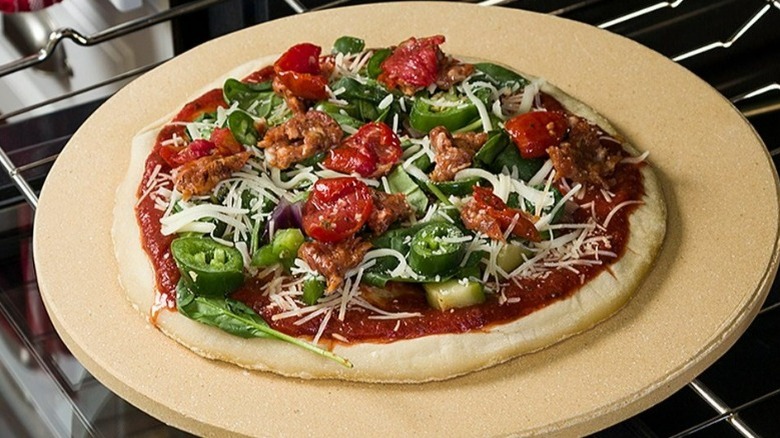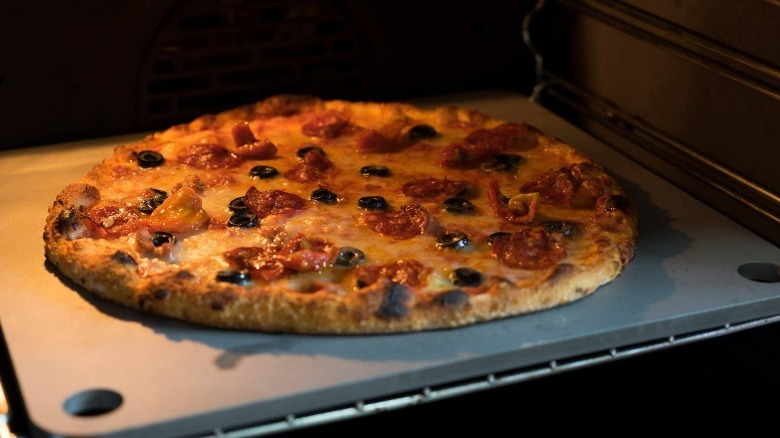Should You Buy A Pizza Stone Or Pizza Steel?
We may receive a commission on purchases made from links.
Making pizza isn't rocket science. So long as you have dough, tomato sauce, and cheese, you've already met the basic requirements. Whether you're using store-bought dough and pre-shredded cheese or you're kneading homemade pizza dough and shredding mozzarella, there's something satisfying about pulling a piping hot pizza pie out of your oven in all its melty glory.
Of course, there are countless ways to improve your pie, whether it's the toppings, the cheese, or the crust itself. Food Network suggests using only a thin layer of sauce to prevent the crust from getting soggy. If you're looking for a way to keep your thin crust from becoming too tough and chewy, PMQ recommends experimenting with the dough's weight and temperature to ensure you get a crisp but still tender crust. No matter what sort of crust you like, chewy or crispy, thick or thin, you almost always find that you get suggestions to use a pizza stone or a pizza steel to help you get the very best crust out of any kind of dough.
But what's the difference between a pizza stone or a pizza steel?
What is a pizza stone?
Food Network describes a pizza stone as a flat place of unglazed clay. Usually round in shape, pizza stones are meant for home ovens. But what exactly does a pizza stone offer compared to the average baking sheet?
As Food Network explains, certain pizza crusts don't work as well in home ovens, as the oven can't get hot enough to cook them properly. One example given is Neapolitan pizzas, which are known for having an incredibly crunchy, almost charred crust that can only be achieved in ovens that can get to a heat of anywhere between 700 and 800 F — something impossible for an average home oven (per Pizza University). The purpose of a pizza stone is to absorb the heat of the oven, similar to how a brick-oven can retain heat, giving the pizza a hotter cooking surface.
Not only does this extra heat ensure that the pizza is fully cooked all the way, but it also lowers the cooking time — more heat means the faster the pizza cooks. It is strongly recommended, however, that you allow your pizza stone to "preheat" in the oven, as a cold pizza stone in a hot oven can lead to the stone cracking or even breaking due to the sudden change in temperature.
What is a pizza steel?
Just as a pizza stone helps conduct and retain heat to help a pizza cook faster, a pizza steel does something similar, albeit with a few minor differences. MasterClass explains that a pizza steel is a thin plate made of incredibly conductive steel that, just like its clay counterpart, absorbs heat to cook the bottom of your pizza. But if both pizza stones and pizza steels do the same job, what makes them different, aside from their materials?
MasterClass explains that a pizza steel can absorb heat much faster and efficiently than a pizza stone, meaning that a pizza placed on a pizza steel will cook much faster than one on a pizza stone. Pizza steels also are resistant to cracking, unlike pizza stones, and they can double as griddles for your stovetop, adds The New York Times. The drawback of a pizza steel, however, is that it's usually more expensive than a pizza stone.
At the end of the day, both pizza stones and pizza steels are very good at what they do: ensuring you get a good, crispy crust on the bottom of your pizza. A pizza stone is best for beginners or those on a budget, while a pizza steel is more for a "professional" pizza maker.


